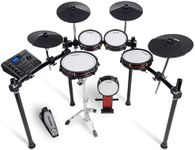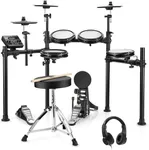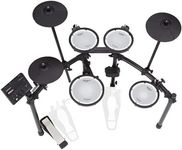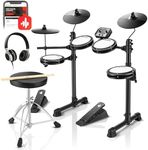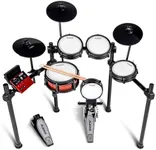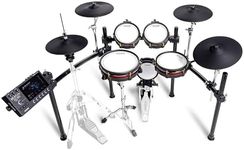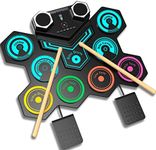Buying Guide for the Best Beginner Electric Drum Kit
Choosing the right beginner electric drum kit can be a fun and rewarding experience. It's important to consider various factors to ensure you get a kit that suits your needs and helps you progress in your drumming journey. Here are some key specifications to look out for and how to navigate them.Number of PadsThe number of pads in an electric drum kit determines how many different drum sounds you can produce. This is important because it affects the range of music you can play and the complexity of your drumming. Kits typically range from 5 to 8 pads. For beginners, a kit with 5 to 6 pads is usually sufficient to cover basic drumming techniques and styles. As you advance, you might want more pads to expand your repertoire.
Pad SensitivityPad sensitivity refers to how responsive the drum pads are to your hits. This is crucial for dynamic playing, allowing you to express different volumes and intensities. Sensitivity can vary from basic to highly responsive. Beginners should look for kits with adjustable sensitivity settings, so you can start with a forgiving setup and increase sensitivity as you improve your control.
Sound QualitySound quality is about how realistic and clear the drum sounds are. High-quality sounds can make practice more enjoyable and help you develop a good ear for drumming. Kits can range from basic electronic sounds to high-fidelity samples of real drums. For beginners, a kit with decent sound quality is important to keep you motivated and ensure you are learning the correct sounds.
Built-in FeaturesBuilt-in features can include metronomes, play-along tracks, and recording capabilities. These features are important for practice and learning. A metronome helps you keep time, play-along tracks make practice fun, and recording capabilities allow you to track your progress. Beginners should look for kits with at least a metronome and some play-along tracks to aid in their learning.
ConnectivityConnectivity options such as USB or MIDI allow you to connect your drum kit to computers or other devices. This is important for using music software, recording, or playing along with digital tracks. Beginners might not need extensive connectivity options initially, but having USB or MIDI can be useful as you progress and start exploring more advanced features.
DurabilityDurability refers to how well the drum kit can withstand regular use. This is important because a durable kit will last longer and provide a better return on your investment. Kits can range from basic plastic construction to more robust materials. Beginners should look for kits that are known for their durability, especially if you plan to practice frequently.
Ease of SetupEase of setup is about how simple it is to assemble and start using the drum kit. This is important because a complicated setup can be frustrating and delay your practice. Kits can range from plug-and-play models to those requiring more detailed assembly. Beginners should look for kits that are easy to set up, so you can start playing quickly without hassle.
